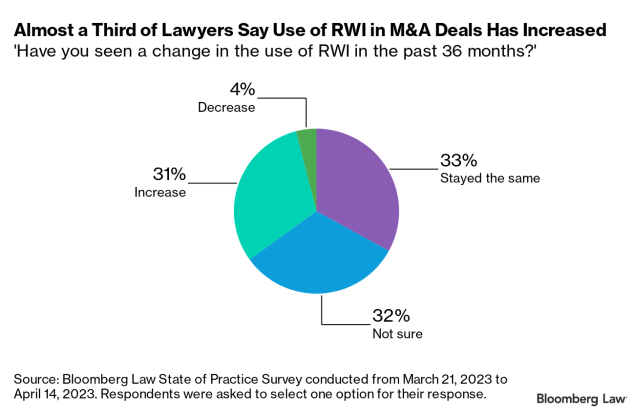Representations and warranties insurance (RWI) appears to have established itself as an important risk-allocation tool for M&A practitioners, based on attorneys’ responses to Bloomberg Law’s most recent State of Practice survey.
RWI protects a party to a merger or acquisition from losses suffered as a result of the other party’s breach of its representations and warranties in an M&A agreement.
Nearly one-third of the lawyers who responded to a survey question on the use of RWI in transactions said that they’ve seen its use increase in the last three years. Only 4% of the respondents said that the use of RWI decreased over the same time span.
These survey responses align with the upward trend I identified earlier this year in the proportion of publicly filed M&A agreements that included references to RWI. Additional survey responses suggest that RWI can have a positive effect on a transaction. For example:
- An average of 42% of M&A deals worked on by respondents in the past 12 months involved a party covered by an RWI policy.
- A majority of respondents (51%) said that RWI favorably impacts transactions.
- Perhaps most importantly, only 5% of respondents said they felt the use of RWI had a somewhat unfavorable impact on transactions—and no one said there was a strongly unfavorable impact.
So what might these responses mean for practitioners?
Keep RWI in mind when discussing deal opportunities, preparing for a transaction, and representing a client in an M&A deal. Although not all transactions are suited for RWI coverage—some deals move too quickly to obtain coverage or are too risky for insurance carriers—now may be a good time to learn about what carriers offer or see what coverage a carrier may be willing to provide. Also consider how obtaining RWI coverage may affect the due diligence process for a particular transaction or the specificity of the representations and warranties included in a purchase agreement.
RWI could affect many aspects of a merger or acquisition for the foreseeable future, and its presence in M&A agreements could even continue its slow climb this year. However, the proportion of deals that involve RWI will likely reach a ceiling eventually, since its use is limited to a smaller sample of transactions in the M&A market in which RWI is valuable or cost-effective for deal parties and carriers.
Bloomberg Law subscribers can find related content on our Surveys, Reports & Data Analysis page. Bloomberg Law subscribers also can find related mergers and acquisitions content on our M&A Deal Analytics resource, as well as our Practical Guidance on Merger R&W and Practical Guidance on Merger Covenants documents.
If you’re reading this on the Bloomberg Terminal, please run BLAW OUT <GO> in order to access the hyperlinked content or click here to view the web version of this article.
Learn more about Bloomberg Law or Log In to keep reading:
See Breaking News in Context
Bloomberg Law provides trusted coverage of current events enhanced with legal analysis.
Already a subscriber?
Log in to keep reading or access research tools and resources.

